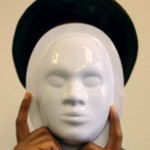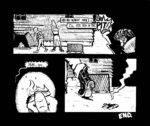“Polaroids: Mapplethorpe” at the Block Museum
Now that Polaroid film is all but extinct—production of the instant film will cease later this year—it is hard to look at those unique and delicate little prints without a sense of nostalgia. The anticipation and eventual (never quite instant enough) gratification that made the process so enticing has, unsurprisingly, been overshadowed by point and shoot digital photography.
Despite the feeling of a bygone era that Polaroids now evoke, the current exhibition at the Block Museum at Northwestern, “Polaroids: Mapplethorpe,” thrives by showing how a young artist made this technology fresh and exciting. Robert Mapplethorpe was new to photography and fresh out of art school when he first picked up a Polaroid model 360 in 1970 to create raw material for the collages he was making at the time. The ninety vintage Polaroids included in the exhibition, none larger than four by five inches, insightfully show a curious and inventive artist discovering the worlds of sexuality, intimacy, urban life, and art through a new medium that he would come to master.
The exhibition spans the six-year period, from 1970 to 1975, in which Mapplethorpe made some 1,500 Polaroid photographs, as he developed into a mature artist. All of the subjects that made him infamous in the 1980s are present—sexually explicit nudes, penetrating portraits, and erotically charged still lifes—and some unfamiliar subjects—cityscapes, commom household objects, and even Mapplethorpe’s upturned feet—appear as well. Unlike the overly polished look of his mature work, Mapplethorpe’s Polaroids show the inventive spontaneity of an artist that does not yet have the answers.
This process of watching him find his way is what makes the show compelling. There are several unremarkable images (a telephone from a worm’s eye view, a pair of shoes, an electrical pole from below) that make you wonder if they would ever be exhibited in a museum if the name Mapplethorpe were not attached to them. Still, we see him experimenting with extreme angles and playing with ways to fill the frame with a figure, as in a dynamic self-portrait where Mapplethorpe’s half naked body elegantly curves around the left side of the photograph while he talks on the telephone.
Though these photographs are not as explicit as one could expect from the Mapplethorpe of the 1980s (sorry, no bull whips up the rectum), the Polaroids, with the scratched, streaky surfaces of the prints and the unrefined poses and crude settings of their subjects, exhibit a raw emotion that was not present in the later work. These photographs show a potentially more intriguing side of Mapplethorpe; one less concerned with perfection and ideals—the lighting is often flawed, the backgrounds rough, and the composition slightly askew—and more focused on finding a way to
see the world.
On view through April 5 at the Mary and Leigh Block Museum of Art, 40 Arts Circle Drive,
Evanston, IL. Tues. 10a.m.–5p.m., Wed.–Fri. 10a.m.–8p.m., Sat.–Sun. 12-5p.m






















